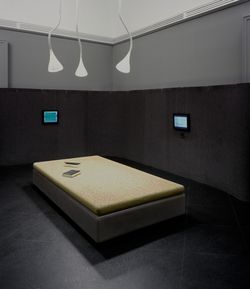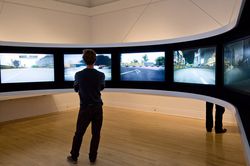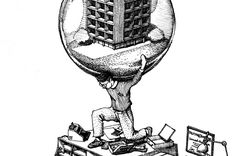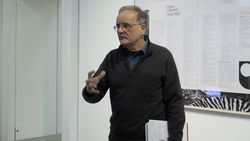Philip Ursprung, guest curator of the 2002 CCA exhibition Herzog de Meuron: Archaeology of the Mind, discusses the Swiss architects’ collaborative relationship with artists. The lecture is part a series exploring the boundary between art and architecture, presented in conjunction with the exhibition. Philip Ursprung is Professor of the History of Modern and Contemporary(...)
17 October 2002
Philip Ursprung: Close Encounters: Herzog & de Meuron en collaboration avec des artistes
Actions:
Description:
Philip Ursprung, guest curator of the 2002 CCA exhibition Herzog de Meuron: Archaeology of the Mind, discusses the Swiss architects’ collaborative relationship with artists. The lecture is part a series exploring the boundary between art and architecture, presented in conjunction with the exhibition. Philip Ursprung is Professor of the History of Modern and Contemporary(...)
research
Visiting Scholars 2000–2001
Theme: The Phenomenon of Paradigm Shifts in Architecture since Antiquity: Oliver Botar, School of Art, University of Manitoba, Winnipeg, Canada Topic: On Biocentrism and Modernism in Weimar German Architecture and Art Fabrizio Nevola, School of Architecture, Syracuse University Florence, Italy Topic: Siena, 1450-1520: From ‘Medieval’ to ‘Renaissance’ City Alessandra(...)
September 2000 to August 2001
Visiting Scholars 2000–2001
Actions:
Description:
Theme: The Phenomenon of Paradigm Shifts in Architecture since Antiquity: Oliver Botar, School of Art, University of Manitoba, Winnipeg, Canada Topic: On Biocentrism and Modernism in Weimar German Architecture and Art Fabrizio Nevola, School of Architecture, Syracuse University Florence, Italy Topic: Siena, 1450-1520: From ‘Medieval’ to ‘Renaissance’ City Alessandra(...)
research
September 2000 to
August 2001
archives
Level of archival description:
Collection
J.J.P. Oud Collection
CI005
Synopsis:
The J.J.P. Oud Collection, 1911-1973, documents J.J.P. Oud's work as an architect between 1911 and 1973. The collection is focussed on Oud’s architectural projects, including work on major exectued and unrealized buildings in the Netherlands, Germany, Czechoslovakia, and the United States. The collection also includes Oud's designs for diverse projects on public housing, war memorials and interior design.
1908-1966 (1911-1963 predominant)
J.J.P. Oud Collection
CI005
Synopsis:
The J.J.P. Oud Collection, 1911-1973, documents J.J.P. Oud's work as an architect between 1911 and 1973. The collection is focussed on Oud’s architectural projects, including work on major exectued and unrealized buildings in the Netherlands, Germany, Czechoslovakia, and the United States. The collection also includes Oud's designs for diverse projects on public housing, war memorials and interior design.
archives
Level of archival description:
Collection institutionnelle
1908-1966 (1911-1963 predominant)
textual records
AP206.S2.072
Description:
File was originally housed in a binder along with content arranged in AP206.S2.073 and AP206.S2.074. This file includes the following papers: "Working with Le Corbusier," 1998 "How Chandigarh got Built" "Jane B. Drew," 1996 "Art as I see it," 1993 "Civilization, Art, Religion" Letters to newspaper editors, 1995 Newspaper articles and Aditya Prakash's response to them Newspaper articles by Aditya Prakash, 1993-1994 Urdu poetry "Modernity in Modern Homes," 1994 "The 'Neem' Soap" "Daydreaming" "A New Capital for Haryana" "Trishanku," 1993 "Oh! To be Equal" "Solar Passive/Active Architecture" "Human Habitat: Environmental Issues and Strategies" "The Maximum and the Minimum"
1986-1998
Published and unpublished papers (folder 1 of 3)
Actions:
AP206.S2.072
Description:
File was originally housed in a binder along with content arranged in AP206.S2.073 and AP206.S2.074. This file includes the following papers: "Working with Le Corbusier," 1998 "How Chandigarh got Built" "Jane B. Drew," 1996 "Art as I see it," 1993 "Civilization, Art, Religion" Letters to newspaper editors, 1995 Newspaper articles and Aditya Prakash's response to them Newspaper articles by Aditya Prakash, 1993-1994 Urdu poetry "Modernity in Modern Homes," 1994 "The 'Neem' Soap" "Daydreaming" "A New Capital for Haryana" "Trishanku," 1993 "Oh! To be Equal" "Solar Passive/Active Architecture" "Human Habitat: Environmental Issues and Strategies" "The Maximum and the Minimum"
textual records
1986-1998
research
Visiting Scholars 1999–2000
Theme: The Baroque Phenomenon beyond Rome: Mark Dorrian, Department of Architecture, University of Edinburgh, Edinburgh, United Kingdom Topic: Baroque Deformation Martina Frank, Department of History, Università degli studi di Udine, Italy Topic: Luca Danesi et le baroque vénitien Indra McEwen, National Theatre School of Canada, Montreal, Canada Subject: The State of(...)
January 2000 to August 2000
Visiting Scholars 1999–2000
Actions:
Description:
Theme: The Baroque Phenomenon beyond Rome: Mark Dorrian, Department of Architecture, University of Edinburgh, Edinburgh, United Kingdom Topic: Baroque Deformation Martina Frank, Department of History, Università degli studi di Udine, Italy Topic: Luca Danesi et le baroque vénitien Indra McEwen, National Theatre School of Canada, Montreal, Canada Subject: The State of(...)
research
January 2000 to
August 2000
Speed Limits
Speed Limits addresses the pivotal role played by speed in modern life: from art to architecture and urbanism to graphics and design to economics to the material culture of the eras of industry and information. It marks the centenary of the foundation of the Italian Futurist movement, whose inaugural manifesto famously proclaimed “that the world’s magnificence has been(...)
Main galleries
20 May 2009 to 8 November 2009
Speed Limits
Actions:
Description:
Speed Limits addresses the pivotal role played by speed in modern life: from art to architecture and urbanism to graphics and design to economics to the material culture of the eras of industry and information. It marks the centenary of the foundation of the Italian Futurist movement, whose inaugural manifesto famously proclaimed “that the world’s magnificence has been(...)
Main galleries
Project
AP075.S1.1961.PR01
Description:
This project series documents Cornelia Hahn Oberlander's landscape project for the Skeena Terrace Low Rent Housing Project, a housing development located on the eastern edge of Vancouver. Oberlander worked on this project between 1961 and 1965. The architectural firm in charge of the project was Underwood, McKinley, Cameron, Wilson & Smith Architects. The project was comprised of an eight-storey apartment tower and twenty-seven three-storey maisonettes. Oberlander was in charge of the landscape design for the twelve-acre site. The project initially included the construction of a roadway cutting the site in two, but was never built due to protests from the community. Oberlander's landscape plan included a design for an outdoor terrace and garden areas for the maisonnettes, a community garden and numerous recreational and social spaces. She also designed play scultpures for small children. The project series contains design development drawings, including landscape plans and planting plans, working drawings, including a site plan and planting plans, a specifications addendum, an invitation to the official inauguration of the project, and photographs, which are mostly of the construction site. Source: Herrington, Susan. Cornelia Hahn Oberlander: Making the Modern Landscape, University of Virginia Press, 2014, 304 pages.
1961-1965
Skeena Terrace Low Rent Housing, Vancouver, British Columbia (1961-1965)
Actions:
AP075.S1.1961.PR01
Description:
This project series documents Cornelia Hahn Oberlander's landscape project for the Skeena Terrace Low Rent Housing Project, a housing development located on the eastern edge of Vancouver. Oberlander worked on this project between 1961 and 1965. The architectural firm in charge of the project was Underwood, McKinley, Cameron, Wilson & Smith Architects. The project was comprised of an eight-storey apartment tower and twenty-seven three-storey maisonettes. Oberlander was in charge of the landscape design for the twelve-acre site. The project initially included the construction of a roadway cutting the site in two, but was never built due to protests from the community. Oberlander's landscape plan included a design for an outdoor terrace and garden areas for the maisonnettes, a community garden and numerous recreational and social spaces. She also designed play scultpures for small children. The project series contains design development drawings, including landscape plans and planting plans, working drawings, including a site plan and planting plans, a specifications addendum, an invitation to the official inauguration of the project, and photographs, which are mostly of the construction site. Source: Herrington, Susan. Cornelia Hahn Oberlander: Making the Modern Landscape, University of Virginia Press, 2014, 304 pages.
Project
1961-1965
Project
CD034.S1.1974.PR01
Description:
This project series contains four reproductions of drawings displayed in the exhibit to document the neighbourhood Quinta do Bacalhau-Monte Coxo, in Lisbon, Portugal. The exhibit text explained the following: The project architect Manuel Vicente was already working on a design for the intervention in the Quintas de Bacalhau and Monte Coxo when he was co-opted by SAAL. The proposed typology referred to another ambitious urban project of 615 housing units, Quinta das Fonsecas - Quinta da Calçada neighbourhood by the architect Raúl Hestnes Ferreira. The intention was to bring the city to the outlying shanty town areas. None of these projects was carried out in full, and they are now fragmented and besieged by the traffic system without having produced any of the essential community and socialising facilities. In Bacalhau-Monte Coxo the structure of the internal patios reveals the ways in which the public space and community was organised. The architecture assigned importance to the facades, although access to the community courtyards was also a central design concept. In a 1976 interview, the architect himself argued that the release of bourgeois guilt allowed for spatial beauty, adopting the slogan 'Facades First' in defence of architectural design. In a way, this proposal anticipated the post-modern, although in a form that did not deny architecture's social engagement. The design emphasizes a strong idea of architectural autonomy, unfortunately only a part of the project was actually built. (The SAAL Process, Housing in Portugal 1974–76) Manuel Vicente worked for SAAL/Lisbon and Central South with the following collaborators: Afonso José Baptista, Agostinho Xavier de Andrade, António Albano Leitão, Cristina Catela Martins Pereira, Eduardo Serrano de Sousa, Gentil Noras, José Manuel Diniz Cabral Caldeira, Manuel Augusto Lopes de Sousa, Nuno Matos Silva, Rita Cabral and the resident association Cooperativa de Habitação Económica Portugal Novo, that was founded on September 6th, 1974. The team built 384 dwellings. The operation began in September 1974, with a construction date in January 1977. This project series contains reproductions of design development drawings and a cadastral plan. The original drawings were produced in 1974 or after and were reproduced in 2015 for the exhibit.
circa 1974
Bairro Quinta do Bacalhau–Monte Coxo, Lisbon
Actions:
CD034.S1.1974.PR01
Description:
This project series contains four reproductions of drawings displayed in the exhibit to document the neighbourhood Quinta do Bacalhau-Monte Coxo, in Lisbon, Portugal. The exhibit text explained the following: The project architect Manuel Vicente was already working on a design for the intervention in the Quintas de Bacalhau and Monte Coxo when he was co-opted by SAAL. The proposed typology referred to another ambitious urban project of 615 housing units, Quinta das Fonsecas - Quinta da Calçada neighbourhood by the architect Raúl Hestnes Ferreira. The intention was to bring the city to the outlying shanty town areas. None of these projects was carried out in full, and they are now fragmented and besieged by the traffic system without having produced any of the essential community and socialising facilities. In Bacalhau-Monte Coxo the structure of the internal patios reveals the ways in which the public space and community was organised. The architecture assigned importance to the facades, although access to the community courtyards was also a central design concept. In a 1976 interview, the architect himself argued that the release of bourgeois guilt allowed for spatial beauty, adopting the slogan 'Facades First' in defence of architectural design. In a way, this proposal anticipated the post-modern, although in a form that did not deny architecture's social engagement. The design emphasizes a strong idea of architectural autonomy, unfortunately only a part of the project was actually built. (The SAAL Process, Housing in Portugal 1974–76) Manuel Vicente worked for SAAL/Lisbon and Central South with the following collaborators: Afonso José Baptista, Agostinho Xavier de Andrade, António Albano Leitão, Cristina Catela Martins Pereira, Eduardo Serrano de Sousa, Gentil Noras, José Manuel Diniz Cabral Caldeira, Manuel Augusto Lopes de Sousa, Nuno Matos Silva, Rita Cabral and the resident association Cooperativa de Habitação Económica Portugal Novo, that was founded on September 6th, 1974. The team built 384 dwellings. The operation began in September 1974, with a construction date in January 1977. This project series contains reproductions of design development drawings and a cadastral plan. The original drawings were produced in 1974 or after and were reproduced in 2015 for the exhibit.
Project
circa 1974
articles
1 November 2020
Natural Disasters: The birth of Homo Dolarensis
Dino Buzzi’s coming of age tale about architecture, cash caves, and modern land development
Actions:
Soon after the opening of The University Is Now on Air: Broadcasting Modern Architecture, Tim Benton presents another reading of the new exhibition through a counter-tour. Rather than a tour through the galleries that gives voice to the curator’s ideas, counter-tours propose critical, subversive, corrective, or alternative versions of a given project through encounters(...)
16 November 2017
Counter-tour: Tim Benton’s Cut
Actions:
Description:
Soon after the opening of The University Is Now on Air: Broadcasting Modern Architecture, Tim Benton presents another reading of the new exhibition through a counter-tour. Rather than a tour through the galleries that gives voice to the curator’s ideas, counter-tours propose critical, subversive, corrective, or alternative versions of a given project through encounters(...)



